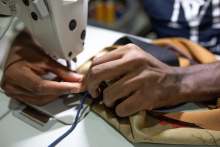Creating a sustainable, plastic-free wardrobe is important due to the huge impact that clothing has on our planet.
Why create a sustainable wardrobe?
The production of clothing has enormous impacts on human rights and our environment. Yet, the vast majority of clothing is disposed of after just a handful of wears.
- Up to 64% of new fabric for clothes is made from plastics.
- In the UK alone we throw 336,000 tonnes of used clothing into landfill every year.
- That’s £140 million worth of used but still usable clothing going to waste every year.
- Each Briton produces 3.1kg of textile waste every year. Only 0.3kg of that is recycled.
- Further to that only 0.4kg of that textile waste is reused.
- British consumers spend on average £980.50 per person on clothing annually
The amount of clothes we consume and the materials they contain is not sustainable and needs to change.
Building a sustainable capsule wardrobe
One of the main ways to live sustainably is to buy less but buy better. This also applies to your wardrobe.
The best bet is to buy any new clothing from reputable, sustainable manufacturers and brands or, even better, buy second-hand organic and sustainable clothing from charity shops.
What is a capsule wardrobe?
The term ‘capsule wardrobe’ was first coined in America in the 1940s to describe a small collection of clothing that were designed to be worn together with complementing colours and lines.
A capsule wardrobe consists of clothes you love, wear and use on a regular basis. The idea is to have a small range of garments that mix and match well to create different outfits. There is no set rule on the amount of clothing you should have but the experts recommend between 25-50 pieces. The total amount is down to the individual but this gives you a guide to work towards.
The main aim of a capsule wardrobe is to have timeless, good quality pieces that you look after, meaning they will last you for many years to come. Although the sustainable pieces may cost you more initially it’s worth it in the long run as, with the correct care, the items should last you a long time. Focus on quality over quantity.
High fashion pieces have no place in a capsule wardrobe as fashions change so often the clothes quickly become redundant.
Declutter your wardrobe
Before you begin to create your new sustainable wardrobe you need to sort through and declutter the items you already have. When you start to look into it you will undoubtedly find outfits that no longer fit, have worn out and may even items you have never worn.
Sociologist Sophie Woodward conducted a study and discovered that 12% of clothes in our wardrobe are unused. Not only are the clothes taking up space in your wardrobe, it’s also a complete waste. Have a clear out, decide what you want to keep and what you don’t and pass on items you no longer need to someone that can make use of them.
The keep or throw dilemma
The question of whether it’s better to keep your existing clothing or replace it with sustainable alternatives is a tricky one. Should you keep an item of clothing and reuse it even if it’s made from polluting materials? The answer isn’t as easy as it seems for a few reasons.
Reusing what you already own
The first rule of living sustainably is to reuse what you already own, rather than adding to your wardrobe or replacing items that are still useful. Even if the item is not made from sustainable materials, or comes from a brand that doesn’t act ethically, it is still better to keep the item as it’s already in circulation.
Throwing it away would only contribute to the waste problem. When the time comes to replace the item, you then have the option to make better choices and opt for sustainable clothing.
But what if that item is made from plastic fibres?
The threat of microplastics
Clothes made from synthetic materials, such as acetate, acrylic, nylon, or polyester release tiny microplastics every time they’re washed. These microplastics end up in our rivers and seas and that is a big problem.
Textiles are one of the two main sources of microplastics in our waterways, along with car tyres (a car tyre sheds 20 grams of plastic every 100km). These microplastics, or microfibres as they’re called when they derive from clothing, are fully ensconced in our food chain and have been found in almost everything that we eat or drink.
- According to National Geographic, in 2019, there were 15 to 51 trillion microplastics particles on the surface of our oceans.
- 83% of water sourced from metropolitan areas across the world is contaminated with microplastics.
- Every year, approximately 1 million tons of microfibres are released into our waterways.
- One fleece jacket releases roughly 250,000 microfibres with every wash.
- Up to 700,000 microfibres can potentially be released from one load of laundry.








